Nghiên cứu các yếu tố trong không gian mua sắm đến hành vi mua hàng ngẫu hứng của người tiêu dùng tại các siêu thị Việt Nam
Khi tiến hành các nghiên cứu trong lĩnh vực Marketing, các nhà tiếp thị đặc
biệt quan tâm đến hành vi mua hàng của người tiêu dùng. Trong đó hành vi mua
hàng ngẫu hứng là một trong những mục tiêu nghiên cứu. Hành vi mua hàng
ngẫu hứng là hành vi mua không có dự định của người tiêu dùng. Nghiên cứu
này làm rõ các yếu tố trong không gian mua sắm tại siêu thị ảnh hưởng thế nào
đến hành vi mua hàng ngẫu hứng của người tiêu dùng. Từ đó các nhà bán lẻ và
nhà tiếp thị có thể thiết lập các phương thức khuyến khích người tiêu dùng mua
hàng ngẫu hứng nhiều hơn, góp một phần không nhỏ vào tổng doanh số bán
hàng tại siêu thị. Nghiên cứu được thực hiện với mẫu là 506 người tiêu dùng
bằng phương pháp định lượng. Kết quả cho thấy bốn yếu tố: (1) Không gian mua
sắm, (2) Bầu không khí trong gian hàng, (3) Trưng bày sản phẩm và (4) Thời
lượng tiếp cận sản phẩm đều ảnh hưởng đến hành vi mua hàng ngẫu hứng của
người tiêu dùng.
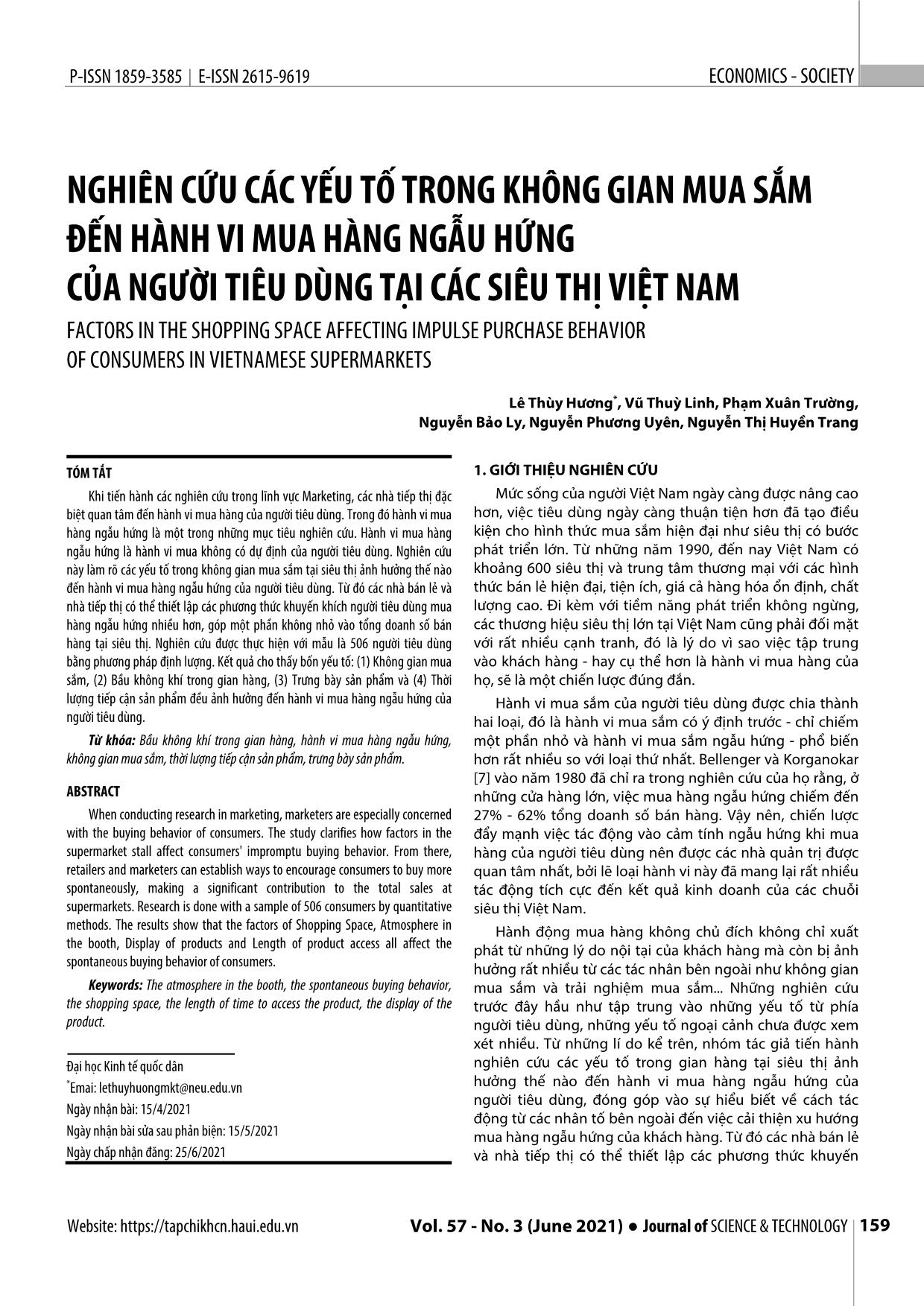
Trang 1
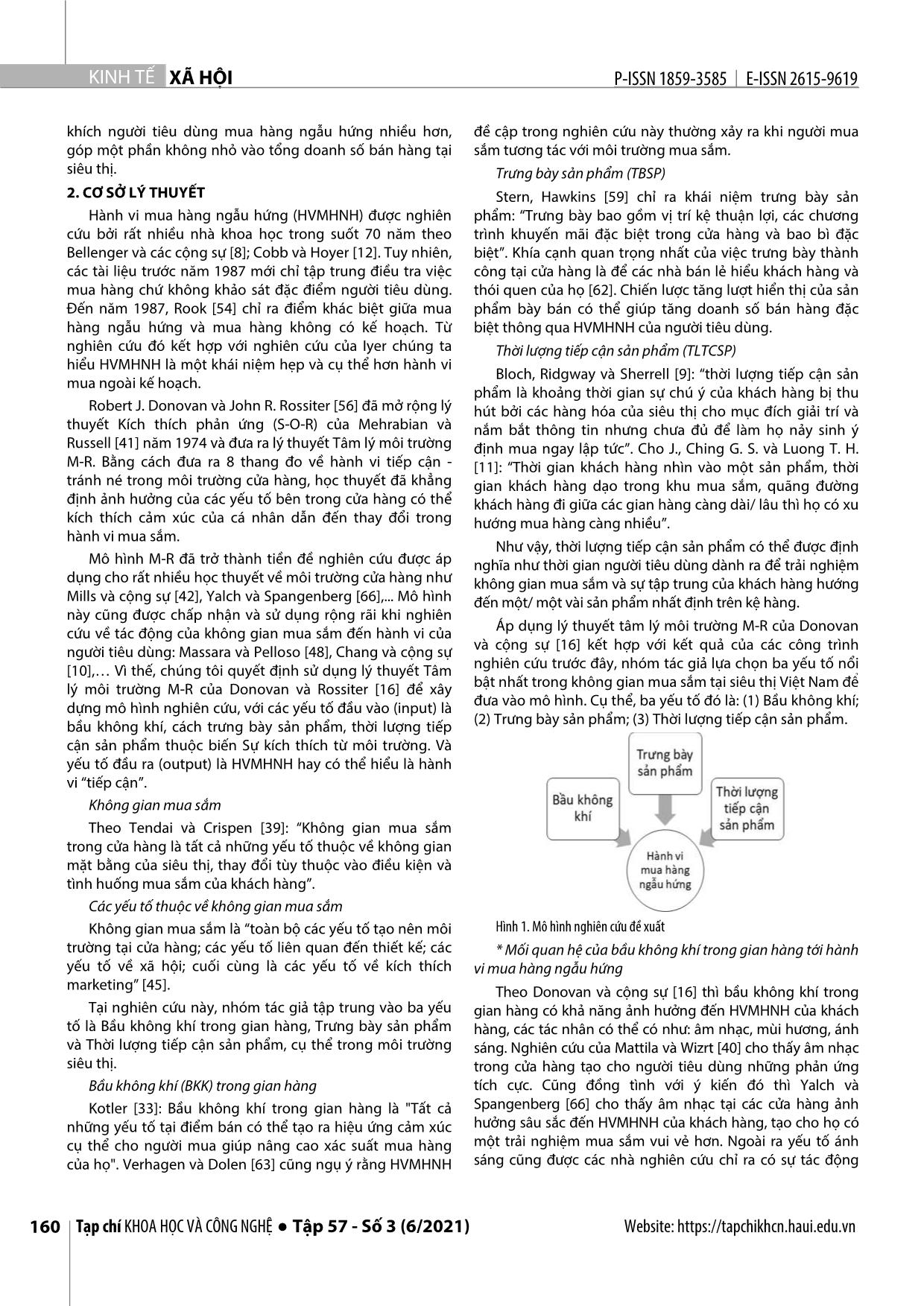
Trang 2
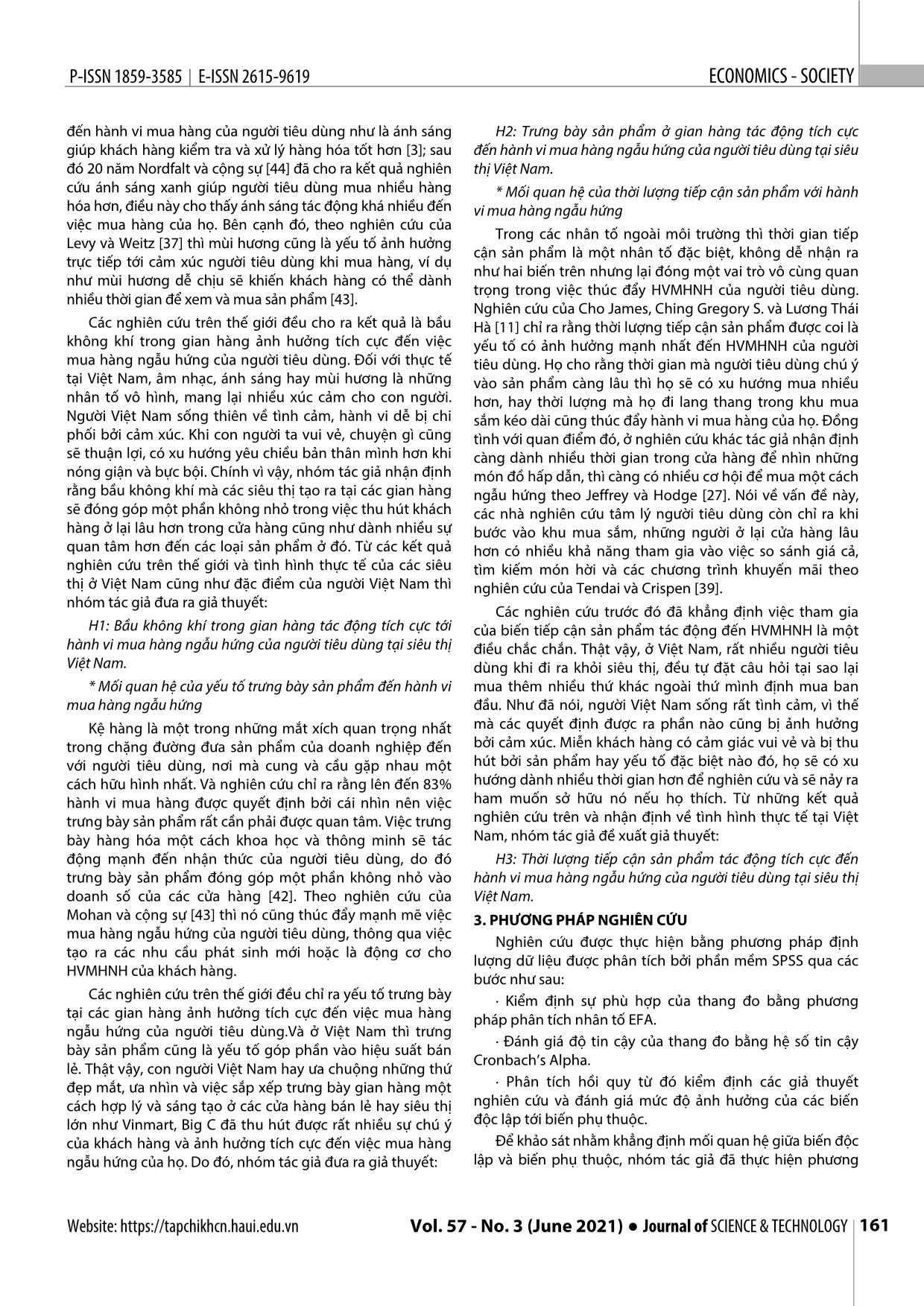
Trang 3
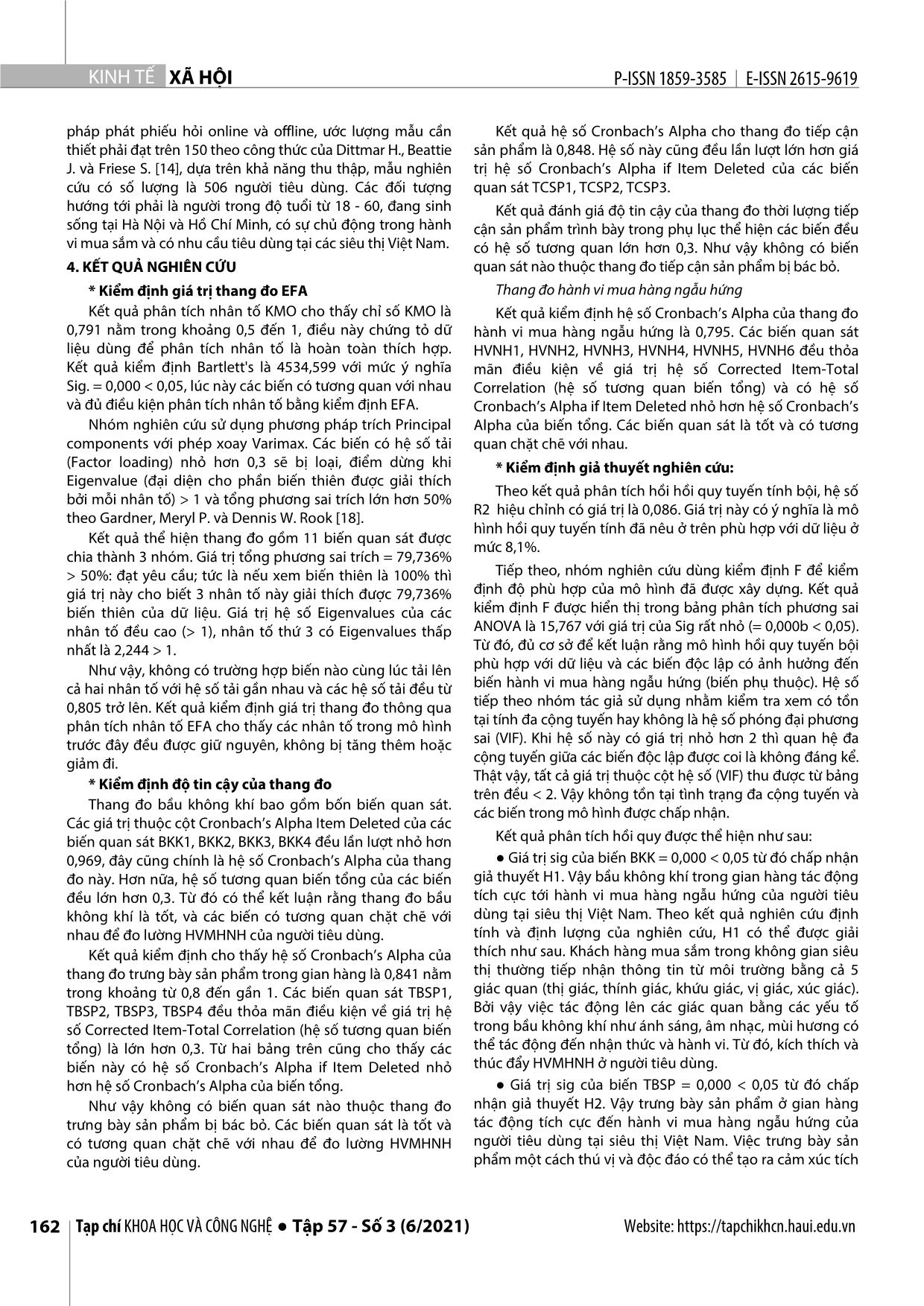
Trang 4
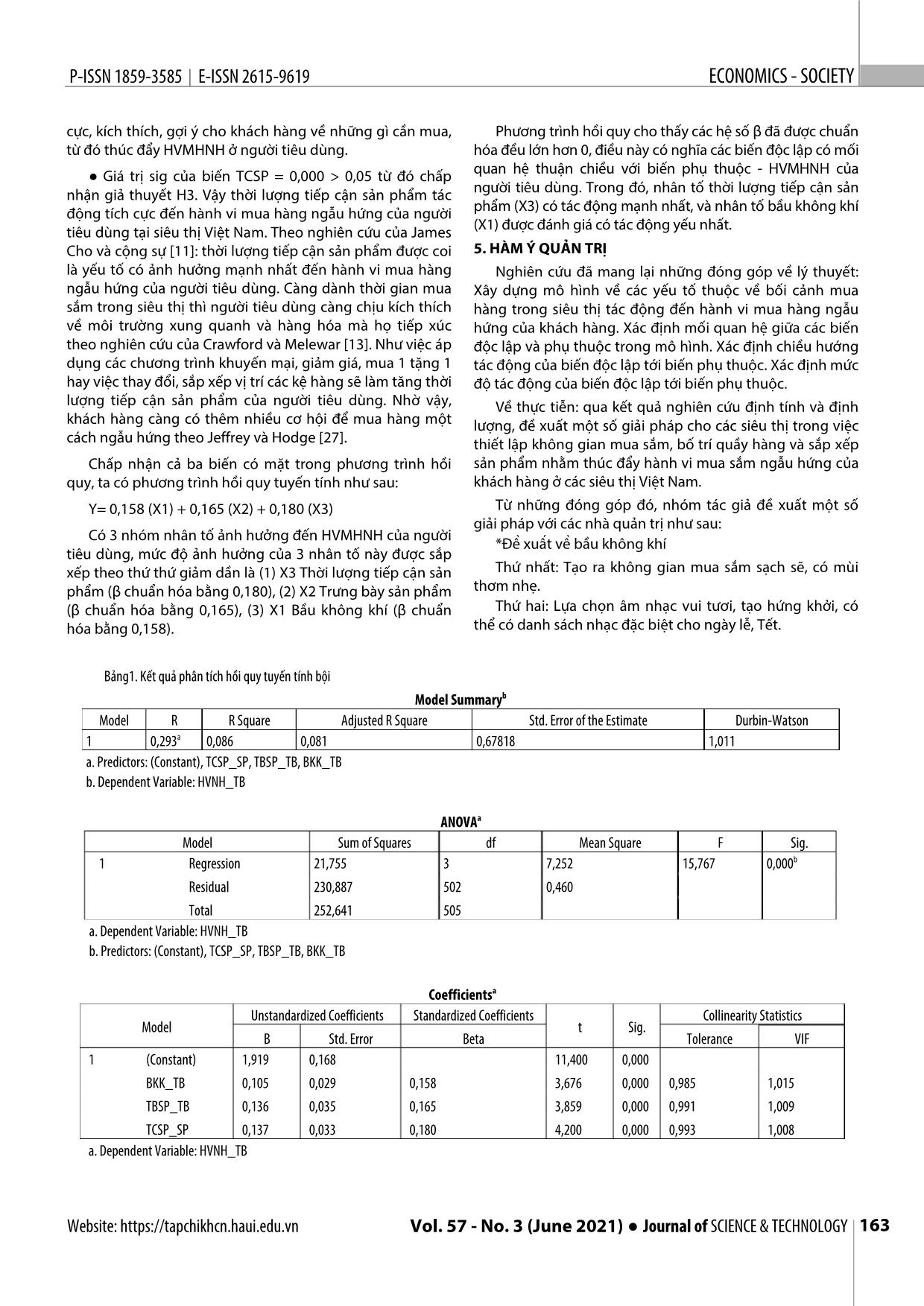
Trang 5
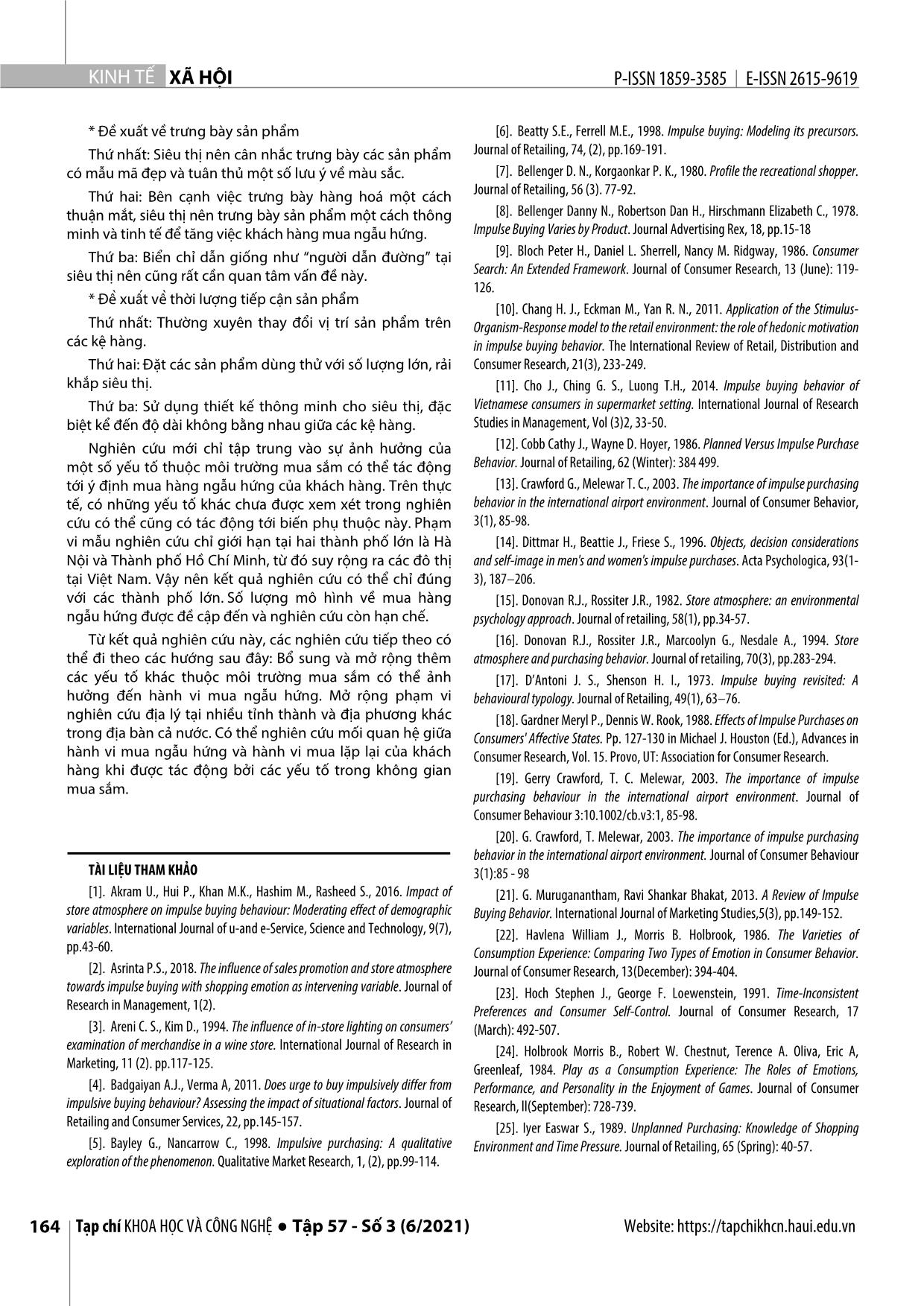
Trang 6
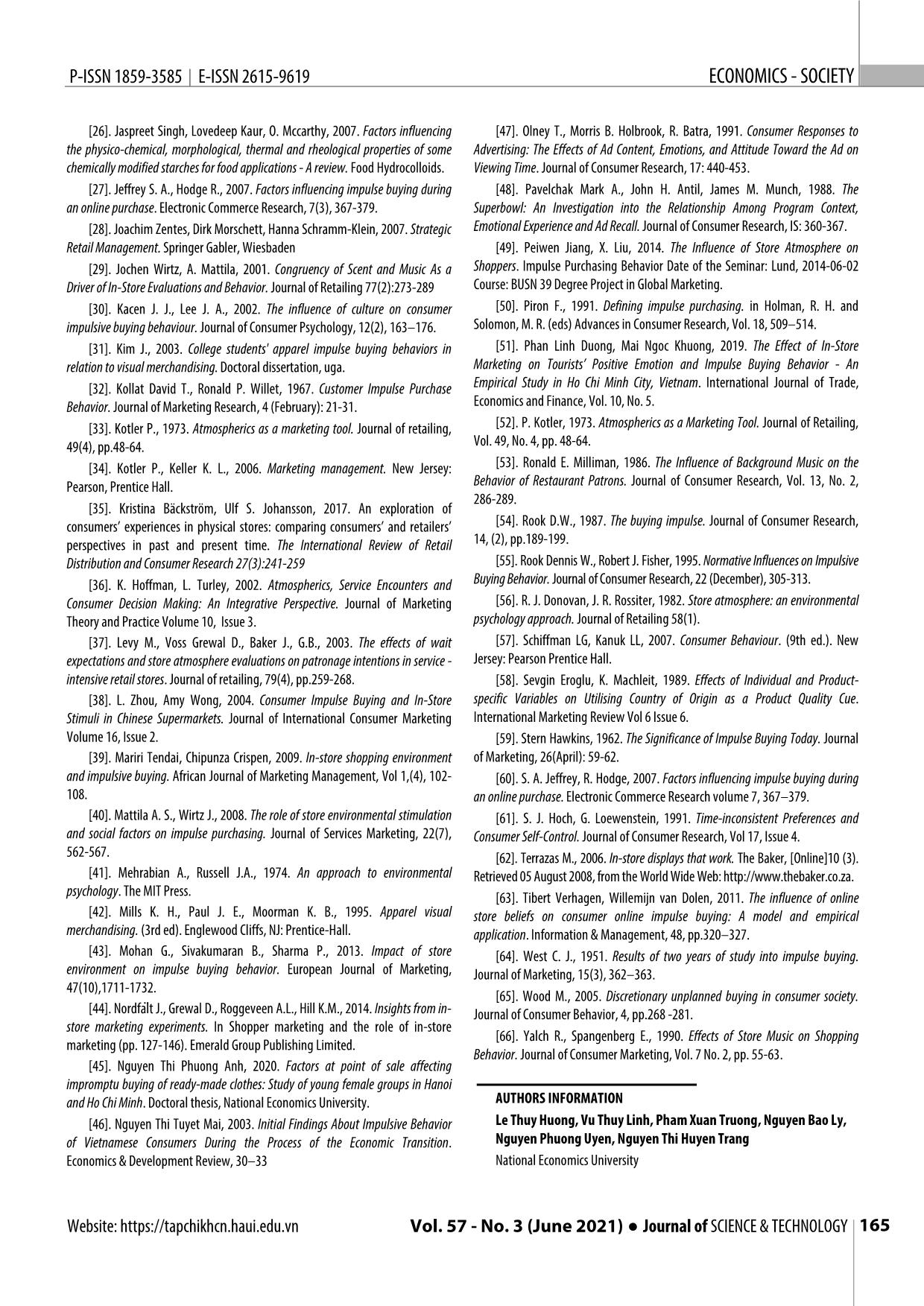
Trang 7
Tóm tắt nội dung tài liệu: Nghiên cứu các yếu tố trong không gian mua sắm đến hành vi mua hàng ngẫu hứng của người tiêu dùng tại các siêu thị Việt Nam
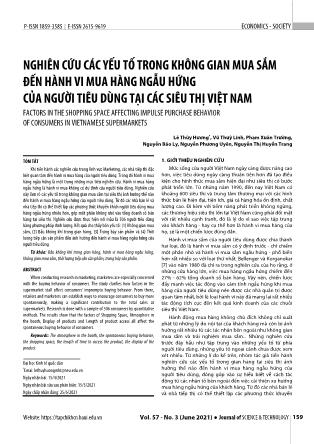
định mức độ tác động của biến độc lập tới biến phụ thuộc. Về thực tiễn: qua kết quả nghiên cứu định tính và định lượng, đề xuất một số giải pháp cho các siêu thị trong việc thiết lập không gian mua sắm, bố trí quầy hàng và sắp xếp sản phẩm nhằm thúc đẩy hành vi mua sắm ngẫu hứng của khách hàng ở các siêu thị Việt Nam. Từ những đóng góp đó, nhóm tác giả đề xuất một số giải pháp với các nhà quản trị như sau: *Đê ̀ xuất vê ̀ bầu không khí Thứ nhất: Tạo ra không gian mua sắm sạch sẽ, có mùi thơm nhẹ. Thứ hai: Lựa chọn âm nhạc vui tươi, tạo hứng khởi, có thể có danh sách nhạc đặc biệt cho ngày lễ, Tết. Bảng1. Kết quả phân tích hồi quy tuyến tính bội Model Summaryb Model R R Square Adjusted R Square Std. Error of the Estimate Durbin-Watson 1 0,293a 0,086 0,081 0,67818 1,011 a. Predictors: (Constant), TCSP_SP, TBSP_TB, BKK_TB b. Dependent Variable: HVNH_TB ANOVAa Model Sum of Squares df Mean Square F Sig. 1 Regression 21,755 3 7,252 15,767 0,000b Residual 230,887 502 0,460 Total 252,641 505 a. Dependent Variable: HVNH_TB b. Predictors: (Constant), TCSP_SP, TBSP_TB, BKK_TB Coefficientsa Model Unstandardized Coefficients Standardized Coefficients t Sig. Collinearity Statistics B Std. Error Beta Tolerance VIF 1 (Constant) 1,919 0,168 11,400 0,000 BKK_TB 0,105 0,029 0,158 3,676 0,000 0,985 1,015 TBSP_TB 0,136 0,035 0,165 3,859 0,000 0,991 1,009 TCSP_SP 0,137 0,033 0,180 4,200 0,000 0,993 1,008 a. Dependent Variable: HVNH_TB XÃ HỘI Tạp chí KHOA HỌC VÀ CÔNG NGHỆ ● Tập 57 - Số 3 (6/2021) Website: https://tapchikhcn.haui.edu.vn 164 KINH TẾ P-ISSN 1859-3585 E-ISSN 2615-9619 * Đề xuất về trưng bày sản phẩm Thứ nhất: Siêu thị nên cân nhắc trưng bày các sản phẩm có mẫu mã đẹp và tuân thủ một số lưu ý về màu sắc. Thứ hai: Bên cạnh việc trưng bày hàng hoá một cách thuận mắt, siêu thị nên trưng bày sản phẩm một cách thông minh và tinh tế để tăng việc khách hàng mua ngẫu hứng. Thứ ba: Biển chỉ dẫn giống như “người dẫn đường” tại siêu thị nên cũng rất cần quan tâm vấn đề này. * Đê ̀ xuâ ́t về thời lượng tiếp cận sản phẩm Thứ nhất: Thường xuyên thay đổi vị trí sản phẩm trên các kệ hàng. Thứ hai: Đặt các sản phẩm dùng thử với số lượng lớn, rải khắp siêu thị. Thứ ba: Sử dụng thiết kế thông minh cho siêu thị, đặc biệt kể đến độ dài không bằng nhau giữa các kệ hàng. Nghiên cứu mới chỉ tập trung vào sự ảnh hưởng của một số yếu tố thuộc môi trường mua sắm có thể tác động tới ý định mua hàng ngẫu hứng của khách hàng. Trên thực tế, có những yếu tố khác chưa được xem xét trong nghiên cứu có thể cũng có tác động tới biến phụ thuộc này. Phạm vi mẫu nghiên cứu chỉ giới hạn tại hai thành phố lớn là Hà Nội và Thành phố Hồ Chí Minh, từ đó suy rộng ra các đô thị tại Việt Nam. Vậy nên kết quả nghiên cứu có thể chỉ đúng với các thành phố lớn. Số lượng mô hình về mua hàng ngẫu hứng được đề cập đến và nghiên cứu còn hạn chế. Từ kết quả nghiên cứu này, các nghiên cứu tiếp theo có thể đi theo các hướng sau đây: Bổ sung và mở rộng thêm các yếu tố khác thuộc môi trường mua sắm có thể ảnh hưởng đến hành vi mua ngẫu hứng. Mở rộng phạm vi nghiên cứu địa lý tại nhiều tỉnh thành và địa phương khác trong địa bàn cả nước. Có thể nghiên cứu mối quan hệ giữa hành vi mua ngẫu hứng và hành vi mua lặp lại của khách hàng khi được tác động bởi các yếu tố trong không gian mua sắm. TÀI LIỆU THAM KHẢO [1]. Akram U., Hui P., Khan M.K., Hashim M., Rasheed S., 2016. Impact of store atmosphere on impulse buying behaviour: Moderating effect of demographic variables. International Journal of u-and e-Service, Science and Technology, 9(7), pp.43-60. [2]. Asrinta P.S., 2018. The influence of sales promotion and store atmosphere towards impulse buying with shopping emotion as intervening variable. Journal of Research in Management, 1(2). [3]. Areni C. S., Kim D., 1994. The influence of in-store lighting on consumers’ examination of merchandise in a wine store. International Journal of Research in Marketing, 11 (2). pp.117-125. [4]. Badgaiyan A.J., Verma A, 2011. Does urge to buy impulsively differ from impulsive buying behaviour? Assessing the impact of situational factors. Journal of Retailing and Consumer Services, 22, pp.145-157. [5]. Bayley G., Nancarrow C., 1998. Impulsive purchasing: A qualitative exploration of the phenomenon. Qualitative Market Research, 1, (2), pp.99-114. [6]. Beatty S.E., Ferrell M.E., 1998. Impulse buying: Modeling its precursors. Journal of Retailing, 74, (2), pp.169-191. [7]. Bellenger D. N., Korgaonkar P. K., 1980. Profile the recreational shopper. Journal of Retailing, 56 (3). 77-92. [8]. Bellenger Danny N., Robertson Dan H., Hirschmann Elizabeth C., 1978. Impulse Buying Varies by Product. Journal Advertising Rex, 18, pp.15-18 [9]. Bloch Peter H., Daniel L. Sherrell, Nancy M. Ridgway, 1986. Consumer Search: An Extended Framework. Journal of Consumer Research, 13 (June): 119- 126. [10]. Chang H. J., Eckman M., Yan R. N., 2011. Application of the Stimulus- Organism-Response model to the retail environment: the role of hedonic motivation in impulse buying behavior. The International Review of Retail, Distribution and Consumer Research, 21(3), 233-249. [11]. Cho J., Ching G. S., Luong T.H., 2014. Impulse buying behavior of Vietnamese consumers in supermarket setting. International Journal of Research Studies in Management, Vol (3)2, 33-50. [12]. Cobb Cathy J., Wayne D. Hoyer, 1986. Planned Versus Impulse Purchase Behavior. Journal of Retailing, 62 (Winter): 384 499. [13]. Crawford G., Melewar T. C., 2003. The importance of impulse purchasing behavior in the international airport environment. Journal of Consumer Behavior, 3(1), 85-98. [14]. Dittmar H., Beattie J., Friese S., 1996. Objects, decision considerations and self-image in men's and women's impulse purchases. Acta Psychologica, 93(1- 3), 187–206. [15]. Donovan R.J., Rossiter J.R., 1982. Store atmosphere: an environmental psychology approach. Journal of retailing, 58(1), pp.34-57. [16]. Donovan R.J., Rossiter J.R., Marcoolyn G., Nesdale A., 1994. Store atmosphere and purchasing behavior. Journal of retailing, 70(3), pp.283-294. [17]. D’Antoni J. S., Shenson H. I., 1973. Impulse buying revisited: A behavioural typology. Journal of Retailing, 49(1), 63–76. [18]. Gardner Meryl P., Dennis W. Rook, 1988. Effects of Impulse Purchases on Consumers' Affective States. Pp. 127-130 in Michael J. Houston (Ed.), Advances in Consumer Research, Vol. 15. Provo, UT: Association for Consumer Research. [19]. Gerry Crawford, T. C. Melewar, 2003. The importance of impulse purchasing behaviour in the international airport environment. Journal of Consumer Behaviour 3:10.1002/cb.v3:1, 85-98. [20]. G. Crawford, T. Melewar, 2003. The importance of impulse purchasing behavior in the international airport environment. Journal of Consumer Behaviour 3(1):85 - 98 [21]. G. Muruganantham, Ravi Shankar Bhakat, 2013. A Review of Impulse Buying Behavior. International Journal of Marketing Studies,5(3), pp.149-152. [22]. Havlena William J., Morris B. Holbrook, 1986. The Varieties of Consumption Experience: Comparing Two Types of Emotion in Consumer Behavior. Journal of Consumer Research, 13(December): 394-404. [23]. Hoch Stephen J., George F. Loewenstein, 1991. Time-Inconsistent Preferences and Consumer Self-Control. Journal of Consumer Research, 17 (March): 492-507. [24]. Holbrook Morris B., Robert W. Chestnut, Terence A. Oliva, Eric A, Greenleaf, 1984. Play as a Consumption Experience: The Roles of Emotions, Performance, and Personality in the Enjoyment of Games. Journal of Consumer Research, ll(September): 728-739. [25]. Iyer Easwar S., 1989. Unplanned Purchasing: Knowledge of Shopping Environment and Time Pressure. Journal of Retailing, 65 (Spring): 40-57. P-ISSN 1859-3585 E-ISSN 2615-9619 ECONOMICS - SOCIETY Website: https://tapchikhcn.haui.edu.vn Vol. 57 - No. 3 (June 2021) ● Journal of SCIENCE & TECHNOLOGY 165 [26]. Jaspreet Singh, Lovedeep Kaur, O. Mccarthy, 2007. Factors influencing the physico-chemical, morphological, thermal and rheological properties of some chemically modified starches for food applications - A review. Food Hydrocolloids. [27]. Jeffrey S. A., Hodge R., 2007. Factors influencing impulse buying during an online purchase. Electronic Commerce Research, 7(3), 367-379. [28]. Joachim Zentes, Dirk Morschett, Hanna Schramm-Klein, 2007. Strategic Retail Management. Springer Gabler, Wiesbaden [29]. Jochen Wirtz, A. Mattila, 2001. Congruency of Scent and Music As a Driver of In-Store Evaluations and Behavior. Journal of Retailing 77(2):273-289 [30]. Kacen J. J., Lee J. A., 2002. The influence of culture on consumer impulsive buying behaviour. Journal of Consumer Psychology, 12(2), 163–176. [31]. Kim J., 2003. College students' apparel impulse buying behaviors in relation to visual merchandising. Doctoral dissertation, uga. [32]. Kollat David T., Ronald P. Willet, 1967. Customer Impulse Purchase Behavior. Journal of Marketing Research, 4 (February): 21-31. [33]. Kotler P., 1973. Atmospherics as a marketing tool. Journal of retailing, 49(4), pp.48-64. [34]. Kotler P., Keller K. L., 2006. Marketing management. New Jersey: Pearson, Prentice Hall. [35]. Kristina Bäckström, Ulf S. Johansson, 2017. An exploration of consumers’ experiences in physical stores: comparing consumers’ and retailers’ perspectives in past and present time. The International Review of Retail Distribution and Consumer Research 27(3):241-259 [36]. K. Hoffman, L. Turley, 2002. Atmospherics, Service Encounters and Consumer Decision Making: An Integrative Perspective. Journal of Marketing Theory and Practice Volume 10, Issue 3. [37]. Levy M., Voss Grewal D., Baker J., G.B., 2003. The effects of wait expectations and store atmosphere evaluations on patronage intentions in service - intensive retail stores. Journal of retailing, 79(4), pp.259-268. [38]. L. Zhou, Amy Wong, 2004. Consumer Impulse Buying and In-Store Stimuli in Chinese Supermarkets. Journal of International Consumer Marketing Volume 16, Issue 2. [39]. Mariri Tendai, Chipunza Crispen, 2009. In-store shopping environment and impulsive buying. African Journal of Marketing Management, Vol 1,(4), 102- 108. [40]. Mattila A. S., Wirtz J., 2008. The role of store environmental stimulation and social factors on impulse purchasing. Journal of Services Marketing, 22(7), 562-567. [41]. Mehrabian A., Russell J.A., 1974. An approach to environmental psychology. The MIT Press. [42]. Mills K. H., Paul J. E., Moorman K. B., 1995. Apparel visual merchandising. (3rd ed). Englewood Cliffs, NJ: Prentice-Hall. [43]. Mohan G., Sivakumaran B., Sharma P., 2013. Impact of store environment on impulse buying behavior. European Journal of Marketing, 47(10),1711-1732. [44]. Nordfa ̈lt J., Grewal D., Roggeveen A.L., Hill K.M., 2014. Insights from in- store marketing experiments. In Shopper marketing and the role of in-store marketing (pp. 127-146). Emerald Group Publishing Limited. [45]. Nguyen Thi Phuong Anh, 2020. Factors at point of sale affecting impromptu buying of ready-made clothes: Study of young female groups in Hanoi and Ho Chi Minh. Doctoral thesis, National Economics University. [46]. Nguyen Thi Tuyet Mai, 2003. Initial Findings About Impulsive Behavior of Vietnamese Consumers During the Process of the Economic Transition. Economics & Development Review, 30–33 [47]. Olney T., Morris B. Holbrook, R. Batra, 1991. Consumer Responses to Advertising: The Effects of Ad Content, Emotions, and Attitude Toward the Ad on Viewing Time. Journal of Consumer Research, 17: 440-453. [48]. Pavelchak Mark A., John H. Antil, James M. Munch, 1988. The Superbowl: An Investigation into the Relationship Among Program Context, Emotional Experience and Ad Recall. Journal of Consumer Research, IS: 360-367. [49]. Peiwen Jiang, X. Liu, 2014. The Influence of Store Atmosphere on Shoppers. Impulse Purchasing Behavior Date of the Seminar: Lund, 2014-06-02 Course: BUSN 39 Degree Project in Global Marketing. [50]. Piron F., 1991. Defining impulse purchasing. in Holman, R. H. and Solomon, M. R. (eds) Advances in Consumer Research, Vol. 18, 509–514. [51]. Phan Linh Duong, Mai Ngoc Khuong, 2019. The Effect of In-Store Marketing on Tourists’ Positive Emotion and Impulse Buying Behavior - An Empirical Study in Ho Chi Minh City, Vietnam. International Journal of Trade, Economics and Finance, Vol. 10, No. 5. [52]. P. Kotler, 1973. Atmospherics as a Marketing Tool. Journal of Retailing, Vol. 49, No. 4, pp. 48-64. [53]. Ronald E. Milliman, 1986. The Influence of Background Music on the Behavior of Restaurant Patrons. Journal of Consumer Research, Vol. 13, No. 2, 286-289. [54]. Rook D.W., 1987. The buying impulse. Journal of Consumer Research, 14, (2), pp.189-199. [55]. Rook Dennis W., Robert J. Fisher, 1995. Normative Influences on Impulsive Buying Behavior. Journal of Consumer Research, 22 (December), 305-313. [56]. R. J. Donovan, J. R. Rossiter, 1982. Store atmosphere: an environmental psychology approach. Journal of Retailing 58(1). [57]. Schiffman LG, Kanuk LL, 2007. Consumer Behaviour. (9th ed.). New Jersey: Pearson Prentice Hall. [58]. Sevgin Eroglu, K. Machleit, 1989. Effects of Individual and Product‐ specific Variables on Utilising Country of Origin as a Product Quality Cue. International Marketing Review Vol 6 Issue 6. [59]. Stern Hawkins, 1962. The Significance of Impulse Buying Today. Journal of Marketing, 26(April): 59-62. [60]. S. A. Jeffrey, R. Hodge, 2007. Factors influencing impulse buying during an online purchase. Electronic Commerce Research volume 7, 367–379. [61]. S. J. Hoch, G. Loewenstein, 1991. Time-inconsistent Preferences and Consumer Self-Control. Journal of Consumer Research, Vol 17, Issue 4. [62]. Terrazas M., 2006. In-store displays that work. The Baker, [Online]10 (3). Retrieved 05 August 2008, from the World Wide Web: [63]. Tibert Verhagen, Willemijn van Dolen, 2011. The influence of online store beliefs on consumer online impulse buying: A model and empirical application. Information & Management, 48, pp.320–327. [64]. West C. J., 1951. Results of two years of study into impulse buying. Journal of Marketing, 15(3), 362–363. [65]. Wood M., 2005. Discretionary unplanned buying in consumer society. Journal of Consumer Behavior, 4, pp.268 -281. [66]. Yalch R., Spangenberg E., 1990. Effects of Store Music on Shopping Behavior. Journal of Consumer Marketing, Vol. 7 No. 2, pp. 55-63. AUTHORS INFORMATION Le Thuy Huong, Vu Thuy Linh, Pham Xuan Truong, Nguyen Bao Ly, Nguyen Phuong Uyen, Nguyen Thi Huyen Trang National Economics University
File đính kèm:
 nghien_cuu_cac_yeu_to_trong_khong_gian_mua_sam_den_hanh_vi_m.pdf
nghien_cuu_cac_yeu_to_trong_khong_gian_mua_sam_den_hanh_vi_m.pdf

